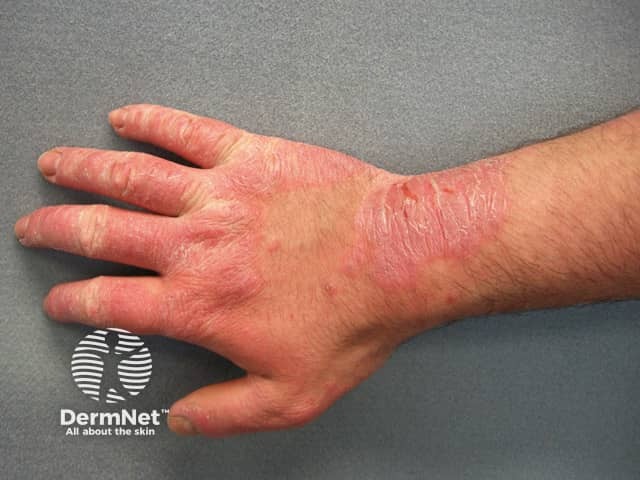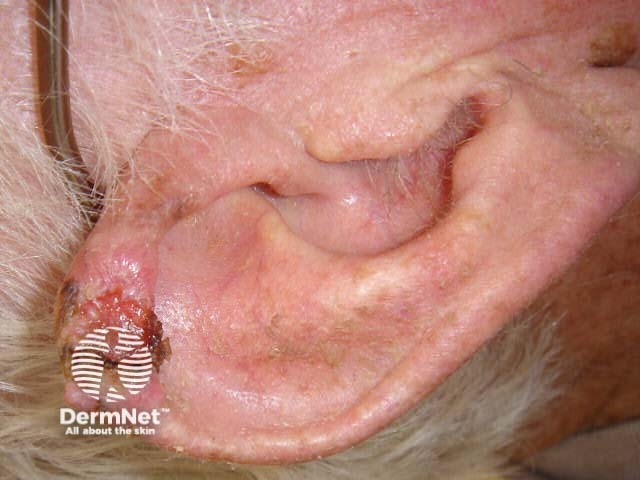Main menu
Common skin conditions

NEWS
Join DermNet PRO
Read more
Quick links
Skin problems in painters and decorators — extra information
Skin problems in painters and decorators
Author: Brian Wu PhD. MD Candidate, Keck School of Medicine, Los Angeles, USA; Chief Editor: Hon A/Prof Amanda Oakley, Dermatologist, Hamilton, New Zealand, February 2016.
Introduction
Occupational risks
Causes
Associated skin conditions
Workplace risk assessment
Diagnosis and treatment
Introduction
There are numerous painters and decorators worldwide involved in the construction and renovation of homes and buildings. However, painting is considered to be a high-risk occupation for skin disorders. In one study, 32% of painters had contact dermatitis. Another study found that the switch to water-based paints has decreased these dangers.
Why are painters/decorators at risk?
Several factors put painters/decorators at risk for occupational skin disorders, including:
- Exposure to a variety of chemicals like solvents, acrylates, formaldehyde, isothiazolinones, epoxy resin, and preservatives.
- Exposure to irritants and corrosives in paints and plasters
- Inconsistent use of personal protective equipment, such as gloves for hand protection, or contact allergy to the equipment (eg, rubber in gloves)
- Uneven global safety regulations for the industry
- A preponderance of workers with low socioeconomic status, low-income levels, and low education and/or illiteracy.
Understanding occupational skin disease
An occupational disease is a risk for workers worldwide. In the United States alone, it affects an estimated 13 million workers. These disorders occur when work-related agents — which can be biological, mechanical, chemical, or physical — breach the protective barrier of the skin. The most common forms of occupational skin disease include dermatitis, skin cancer, mechanical injuries to the skin, and skin infections.
Skin conditions associated with painters and decorators
Skin conditions that are common in painters and decorators can include the following.
Contact dermatitis
- Contact dermatitis can be allergic or irritant in nature.
- Allergic contact dermatitis is an immune response to a chemical in sensitive individuals.
- Irritant contact dermatitis is an inflammatory response to a single or repetitive exposure to a toxin or injury.
- Most common signs and symptoms include redness, swelling, pain or burning, itching and dry, blistered, flaking, or cracked skin.
- In the painting profession, epoxy resin is the most frequent cause of contact dermatitis.
Mechanical injury
- Most common injuries in painters and decorators are cuts and abrasions.
- They can result from the use of tools and equipment.
- Education is needed on safe use of tools and equipment.
- Secondary bacterial skin infections can result from these injuries.
Exposure to solar radiation
- Outdoor work, such as painting exteriors of houses, is associated with exposure to ultraviolet (UV) radiation.
- UV radiation causes skin ageing and increases the risk of squamous and basal cell carcinomas and melanoma.
- Use of sunscreens, sun protective clothing, and staying indoors during the middle of the day can reduce sun damage.
- Workers should be educated about the symptoms of skin cancer and seeking treatment.
Skin problems in painters and decorators

Dermatitis due to rubber gloves

Positive patch tests to rubber and epoxy

Squamous cell cancer
Workplace risk assessment
An effective workplace risk assessment should take into account:
- General work conditions
- Knowledge of chemical substances in the workplace
- Protocols for working with toxic substances
- Presence of personal protective equipment.
Methods to increase safety include:
- On-site washing facilities with hot and cold water
- Substitution of hazardous substances with less hazardous ones
- Regular employee health checks.
Personal protective equipment
Gloves for hand protection are recommended when working with paints, adhesives, epoxy resins, and other hazardous chemicals. Cloth gloves should be avoided when working with plasters and other corrosives, as these are inadequate for protection. Hard hats, work boots, protective clothing, and masks also increase general worker safety.
Education on personal protective equipment is needed to ensure that it is used correctly and safely.
Hand care advice for painters and decorators
- Wash hands thoroughly with gentle soap and water, then thoroughly dry as needed.
- Apply emollients/moisturisers.
- Do not use solvents to clean hands.
- Choose the right kind of gloves for the right task (check with safety shop).
- Know and report early signs of dermatitis.
Diagnosis and treatment of occupational skin disease
Diagnosis of an occupational skin disease should be based on:
- Medical examination and evaluation of patient history
- Occupational assessment, including work routine and tasks, workplace chemicals, amount of time on the job, and safety protocols at work
- Patient signs and symptoms, the location of affected areas, and whether or not symptoms improve away from work
- Patch testing may be arranged if allergic contact dermatitis is suspected.
Treatment can include:
- Topical steroids and systemic steroids
- Emollients
- Avoidance of the causative irritant or contact allergen
- Referral to a dermatologist if dermatitis persists or resists simple treatments.
References
- Chemical Exposure and Health Hazards Among House Painters. Finnish Institute of Occupational Health. 2002.
- Health and Safety Advice for Painters and Decorators. CITB-Construction Skills, Northern Ireland.
- Skin Exposure and Effects. National Institute of Occupational Safety and Health. 2014.
- Peate, W.F. Occupational Skin Disease. American Family Physician. 2002. 66(6) 1025–33. Journal
- Wieslan, G. Occupational Exposure to Water-Based Paint and Symptoms of the Skin and Eyes. Occupational and Environmental Medicine. 1994. 51(3) 181–6. PubMed
